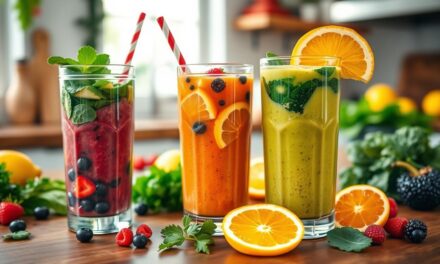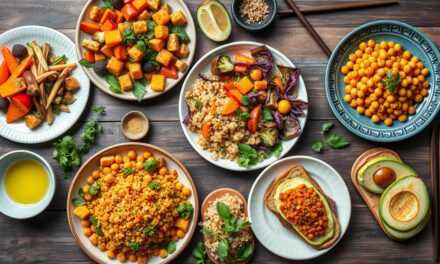Can one meal give you all the nutrients you need for health? The vegan buddha bowl might be the answer. It’s a bowl filled with healthy, plant-based foods. In Australia, where eating well is key, this bowl is getting more popular.
Making a balanced vegan buddha bowl takes thought. It needs a mix of plant-based foods like grains, greens, and proteins. This mix in a bowl can boost your health and wellbeing.
Key Takeaways
- A vegan buddha bowl provides a balanced mix of nutrients for optimal health and wellbeing.
- A plant-based bowl filled with wholesome ingredients supports overall wellbeing.
- A nourishing bowl of goodness can be created with a variety of plant-based foods.
- Whole grains, leafy greens, and plant-based proteins are essential components of a vegan buddha bowl.
- A well-crafted vegan buddha bowl can support overall health and wellbeing in Australia.
- A balanced vegan buddha bowl requires careful consideration of ingredients and portion sizes.
- A vegan buddha bowl is a great option for individuals looking for a healthy and nutritious meal.
Understanding the Vegan Buddha Bowl Concept
The vegan Buddha bowl idea is all about healthy eating and using plants as the main food source. It’s a bowl filled with whole grains, leafy greens, and proteins from plants. This kind of meal is good for our health and also helps the environment.
A vegan Buddha bowl has foods that give you a good mix of nutrients. You’ll often find:
- Whole grains like brown rice, quinoa, or whole wheat
- Leafy greens such as kale, spinach, or collard greens
- Plant-based proteins like chickpeas, lentils, or tofu
By mixing these foods, you make a meal that’s both healthy and kind to the planet. The secret to a great vegan Buddha bowl is to eat healthily and use lots of plant-based ingredients.
The vegan Buddha bowl idea is about making a balanced and eco-friendly meal. It encourages healthy eating and helps reduce harm to the environment. By knowing what makes up a vegan Buddha bowl, you can make your own tasty and nutritious meals.
| Component | Benefits |
|---|---|
| Whole grains | High in fiber, rich in nutrients |
| Leafy greens | Rich in vitamins and minerals, high in antioxidants |
| Plant-based proteins | High in protein, low in saturated fat |
Essential Equipment and Kitchen Setup
To make a tasty vegan Buddha bowl, you need the right tools and a good kitchen setup. A colorful bowl makes eating more fun. Pick a wholesome bowl that looks good and works well.
Here are some key items for your kitchen:
- A variety of utensils, such as a chef’s knife, cutting board, and spatulas
- A set of wholesome bowls in different sizes for serving and storing food
- Storage containers for ingredients and leftovers
- A blender or food processor for preparing sauces and dressings
A tidy kitchen helps you cook better. Think about getting a kitchen cart or island for more space and storage. A colorful bowl can brighten up your kitchen.
With the right tools and kitchen, making vegan Buddha bowls is easy. Choose a wholesome bowl that shows your style and makes meals special.
| Equipment | Description |
|---|---|
| Cutting Board | A durable cutting board for chopping ingredients |
| Chef’s Knife | A sharp chef’s knife for slicing and dicing ingredients |
| Storage Containers | A set of containers for storing ingredients and leftovers |
Choosing Your Base Ingredients
Creating a tasty and healthy vegan meal starts with the right ingredients. A cruelty-free bowl needs whole grains, leafy greens, and plant-based proteins. These add nutrients, texture, flavor, and variety.
Start with whole grains like quinoa, brown rice, and whole wheat. They’re full of protein, fiber, vitamins, and minerals. For instance, quinoa has all nine essential amino acids the body needs.
Whole Grains Options
- Quinoa: complete protein, rich in iron and magnesium
- Brown rice: high in fiber, manganese, and selenium
- Whole wheat: good source of vitamin E, copper, and phosphorus
Leafy greens like kale, spinach, and broccoli are also key. They’re full of vitamins A, C, and K, and minerals like calcium and iron. You can add them to your bowl in many ways, like sautéed, steamed, or raw.
Leafy Greens Selection
- Kale: rich in vitamins A, C, and K, as well as minerals like calcium and iron
- Spinach: high in iron, calcium, and vitamins A and K
- Broccoli: good source of vitamin C, vitamin K, and fiber
Plant-based proteins like tofu, tempeh, and chickpeas add protein. They can be seasoned and cooked in many ways to enhance your cruelty-free bowl’s flavor and texture.
| Protein Source | Protein Content (per serving) |
|---|---|
| Tofu | 20-25 grams |
| Tempeh | 15-20 grams |
| Chickpeas | 10-15 grams |
Creating the Perfect Balance of Nutrients
To make a nourishing bowl, you need to balance macronutrients and micronutrients. A vegan Buddha bowl should have whole foods like grains, greens, and plant proteins. This balance keeps your energy up and supports your health.
When making your bowl, think about these key parts:
- Complex carbs like brown rice or quinoa for lasting energy
- Leafy greens like kale or spinach for vitamins and minerals
- Plant proteins like chickpeas or tofu for muscle health
A balanced bowl gives you the nutrients you need for health. It also makes your meal delicious and good for your mind and body.
For instance, a bowl with brown rice, roasted veggies, and chickpeas is great. It has the right mix of nutrients for healthy eating.
| Food Group | Examples | Nutritional Benefits |
|---|---|---|
| Whole Grains | Brown rice, quinoa, whole wheat | Complex carbs, fiber, and minerals |
| Leafy Greens | Kale, spinach, collard greens | Vitamins A, C, and K, and minerals like calcium and iron |
| Plant-Based Proteins | Chickpeas, tofu, lentils | Protein, fiber, and various vitamins and minerals |
Understanding the need for nutrient balance helps you make a nourishing bowl. This bowl supports healthy eating and overall well-being.
The Art of Building Your Buddha Bowl
Making a beautiful vegan Buddha bowl is an art. It needs detail and creativity. A plant-based bowl should look good and taste great. To do this, focus on layering, portion control, and color.
Layering Techniques
Layering is key in making a Buddha bowl. Start with whole grains like brown rice or quinoa. Then add colorful veggies like leafy greens, bell peppers, and carrots. Finish with plant-based proteins like chickpeas, tofu, or tempeh, and a drizzle of dressing.
Portion Control Guidelines
To make your bowl just right, follow these tips:
- Whole grains: 1/2 cup cooked
- Vegetables: 1-2 cups mixed
- Protein sources: 1/2 cup cooked
- Dressing: 2-3 tablespoons
Colour Combination Tips
A colorful bowl is not just pretty; it’s also packed with nutrients. Mix different colored veggies for a vibrant bowl. Try green veggies with orange bell peppers and red carrots. Add fresh herbs like parsley or cilantro for extra freshness.
By using these tips, you can make a stunning, healthy bowl. It will nourish you and delight your taste buds.
Mastering Flavourful Dressings and Sauces
To make your vegan buddha bowl even better, learn to make tasty dressings and sauces. A great dressing can tie everything together, adding flavor and texture.
Here are some tips for making tasty dressings and sauces:
- Choose top-notch, wholesome ingredients like cold-pressed oils and fresh herbs.
- Try different mixes of ingredients to find the perfect flavor balance.
- Remember, a little salt or fresh lemon juice can really boost the taste.
A vegan buddha bowl needs a tasty dressing or sauce. Options like tahini sauces, citrus vinaigrettes, and creamy cashew dressings are great. Learning to make these can elevate your wholesome bowl and make it a satisfying, nutritious meal.

With a bit of practice and trying new things, you can make many tasty dressings and sauces for your vegan buddha bowl. So, don’t hesitate to be creative and find the perfect flavor mix for your wholesome bowl.
| Dressing/Sauce | Ingredients | Instructions |
|---|---|---|
| Tahini Sauce | Tahini, lemon juice, garlic, water | Blend all ingredients together until smooth |
| Citrus Vinaigrette | Orange juice, apple cider vinegar, olive oil | Whisk all ingredients together until well combined |
Seasonal Ingredient Guide for Australian Produce
Choosing seasonal ingredients is key for a tasty and healthy plant-powered meal. In Australia, what’s in season changes with the seasons. This way, you get the best taste and nutrition, help local farmers, and cut down on waste.
Australia’s climate means we have a lot of fresh produce all year. Summer brings stone fruits, corn, and leafy greens. Winter is all about root veggies, citrus, and avocados. Using these seasonal foods makes your bowl both tasty and good for you.
Summer Options
- Stone fruits: peaches, nectarines, and plums
- Corn: fresh, grilled, or roasted
- Leafy greens: kale, spinach, and lettuce
Winter Alternatives
- Root vegetables: carrots, sweet potatoes, and beets
- Citrus: oranges, lemons, and limes
- Avocados: a great source of healthy fats
Year-Round Staples
- Leafy greens: kale, spinach, and lettuce
- Avocados: a great source of healthy fats
- Nuts and seeds: almonds, chia seeds, and quinoa
By using this guide, you can make a meal that’s not just yummy but also good for the planet. Always pick seasonal ingredients for the best taste and nutrition in your bowl.
Time-Saving Prep and Storage Solutions
Embracing a vegan lifestyle can be easy with the right meal prep. A well-planned vegan meal saves time and keeps healthy ingredients ready. Cooking in bulk lets you make different dishes all week.
Batch cooking and portion control are key strategies. They help you make a variety of vegan meals, from bowls to salads. These methods make healthy eating simple.

- Store fruits and veggies separately to avoid moisture transfer
- Label and date ingredients to use them before they spoil
- Use airtight containers to keep cooked meals and ingredients fresh
Using these prep and storage tips makes healthy eating easy. You can enjoy a variety of vegan meals without losing convenience. With a bit of planning, a balanced vegan lifestyle is within reach.
| Meal Prep Strategy | Benefits |
|---|---|
| Batch Cooking | Saves time, reduces food waste, and promotes healthy eating |
| Portion Control | Encourages mindful eating, helps with weight management, and reduces food waste |
Customising Your Vegan Buddha Bowl for Different Dietary Needs
Creating a vegan Buddha bowl means thinking about everyone’s dietary needs. A cruelty-free bowl can be tailored for gluten-free, soy-free, or raw food diets.
To craft a wholesome bowl, pick a base that fits the diet. Brown rice or quinoa are good gluten-free choices. Then, add colourful veggies like leafy greens, bell peppers, and carrots.
For a cruelty-free bowl, swap out ingredients for similar ones. Use tamari or coconut aminos instead of soy sauce. This way, everyone can enjoy a meal that’s balanced and satisfying, no matter their dietary limits.
- Using fresh, seasonal ingredients to ensure the best flavour and texture
- Adding a source of protein, such as chickpeas or tofu, to keep you full and satisfied
- Experimenting with different spices and herbs to add flavour and depth to the dish
By following these tips, you can make a wholesome bowl that meets many dietary needs. It’s perfect for a meal or snack.
Common Mistakes to Avoid When Preparing Buddha Bowls
When making a vegan buddha bowl, it’s key to avoid common mistakes. These can affect the dish’s quality and nutritional value. A balanced bowl needs careful attention to ingredients, storage, and handling.
Watch out for ingredient imbalance. This means not having the right mix of grains, vegetables, and proteins. Another error is overcooking, which can make the dish lose nutrients and texture.
Ingredient Balance Issues
- Insufficient protein sources
- Imbalanced ratio of complex carbohydrates to healthy fats
- Inadequate variety of colorful vegetables
Preparation Pitfalls
To avoid mistakes in preparation, follow good cooking techniques and handle ingredients carefully. This means chopping vegetables evenly, cooking grains just right, and seasoning with herbs and spices to boost flavor.
Storage Errors
Proper storage and handling of ingredients and bowls are crucial for safety and freshness. Keep ingredients in a cool, dry spot, label and date containers, and eat bowls within a day or two.
| Mistake | Solution |
|---|---|
| Ingredient imbalance | Follow a balanced recipe or consult a nutritionist |
| Overcooking | Cook ingredients until tender but still crisp |
| Storage errors | Store ingredients and prepared bowls in a cool, dry place |
By knowing these common mistakes and how to avoid them, you can make a tasty and healthy vegan buddha bowl. It will be both satisfying and nutritious.
Conclusion: Embracing the Buddha Bowl Lifestyle
The nourishing bowl of a vegan Buddha bowl is a great way to feed your body and soul. It’s a tasty, plant-powered meal that gives you energy and satisfaction.
Vegan Buddha bowls are very flexible. You can mix different whole grains, leafy greens, and plant proteins to make tasty meals. Soon, you’ll get good at mixing flavors and textures for a dish that’s both delicious and healthy.
We suggest making vegan Buddha bowls a regular part of your meals. They’re good for your health and wellbeing. Start exploring plant-based eating and let the Buddha bowl lifestyle help you live a healthier, more vibrant life.





